|
British Colours (4) -- Patterns
1778-1800
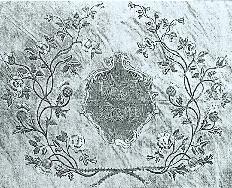 |
The second common standardized
type, presumably from a single source in England, or possibly
Scotland, was presented to the 82d, 93d, and
95th Regiments in 1778, 1781, and 1782. Colours
of this pattern belonging to the 95th were carried
against the French invasion of Jersey in 1781, and are the major
focus in John Singleton Copley’s monumental "Death of Major
Pierson" painted in 1783. Copley was known for his meticulous
attention to detail in uniform and equipment and may well have had
the original colours to work from. Left: Center
of regimental colour, 93d Foot, 1781. This short-lived
regiment was raised at Fort George in northern Scotland and
disbanded at the end of the Ameican War for Independence.
(Milne) Right: Colours
of 82d Foot, the Duke of Hamilton's Regiment, 1778.
Note that although wreath laps over onto white fimbriation, it does
not reach to St Andrew's cross, also that the St Andrew's cross is
very narrow. These colours were carried in America.
(Ross) |
 |
The wreath on this pattern is neat
and symmetric, with the left and right sections virtually
identical, as well as much larger than the rococo type. The wreath
is almost circular, and no attempt is made to fit it into the
center of the St George’s cross—this is the earliest pattern in
which the wreath spills out onto the white fimbriation on the
King’s color. Nevertheless, none of the foliage or flowers reaches
anywhere near the diagonal St Andrew’s cross nor the blue
field. |
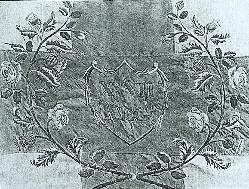 |
About 1790 a much simpler
wreath and heart-shaped shield became the standard. The new
design was about the same in overall size as the
style described above—the roughly circular wreath lapped over
onto the white fimbriation, but still no part extended onto the St
Andrew’s cross or the blue field. This design, with only minor
variations, remained in use until after the Napoleonic period. The
design was often painted; though painting had been authorized from
the earliest warrants, its use had been fairly rare. Left: Center of
King's colour, 28th Foot, 1795. Note how little of wreath
extends into white fimbriations. (Milne) Right:
Regimental colours, 2d Battalion, 40th Foot, 1799-1802.
Note size of wreath on King's colour--it barely extends into
fimbriations, which are still quite wide--and that wreath is same
size on both colours. Highest parts of wreath on regimental
colour are below level of union. The little tail descending from
the lower corner of union is the "pile wavy" denoting 2d Battalion.
(Regt Hist) |
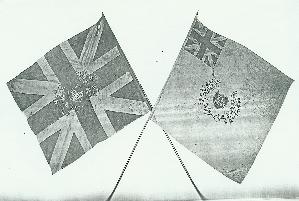 |
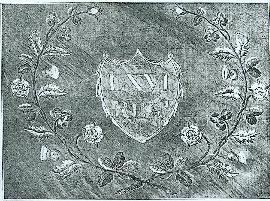 |
In 1801 all colours were
required to represent the new Union with Ireland. Many
existing colors were physically altered by embroidering shamrocks
wherever they could be crammed into the design on the wreaths and
by unstitching the St Andrew’s cross and modifying or replacing it
with the correct cross counter-charged red and white. Sometimes
mistakes were made—the well-known colour of the Quebec Militia has
the counter-charged crosses in the wrong positions, the colour of
the 85th Regiment (the Bucks) and carried at Bladensburg
in 1814, has the correctly altered union, but no shamrocks added to
the wreath. Left: Center
of the regimental colour 66th Foot, 1815. It is virtually
identical to wreath introduced in 1790 except that some of the rose
and thistle leaves have been replaced with shamrocks, and the roses
are heraldic Tudor roses rather than natural garden roses.
Note that the union of this flag cannot be seen, the wreath does
not extend that high. (Milne) Right: Colours
of 2d Battalion, 21st Foot, the Royal North British Fuziliers,
1814. The fimbriations are very close to Napier's original
drawing of 1747, still wider than most later drawings would
suggest. The counter-charged crosses of St Andrew and St
Patrick are also quite accurately made. The white cross
should be slightly wider than the red because it theoretically
includes a white fimbriation equal to that on opposite side
of the red cross. (Ross) |
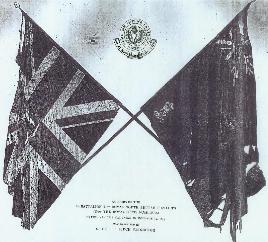 |
Copyright © 2013 Web Design by Web.com Group, Inc. |